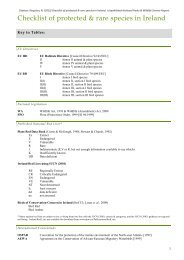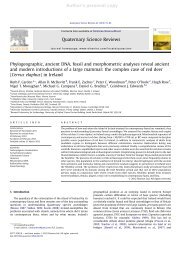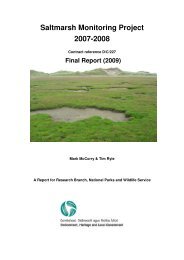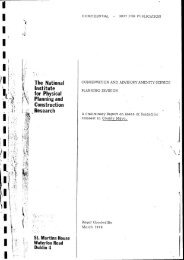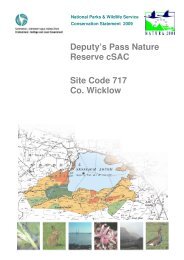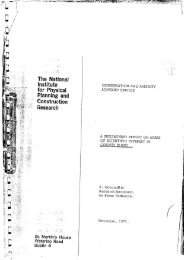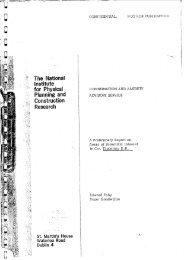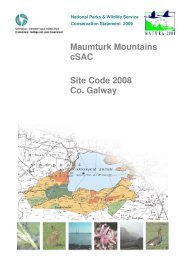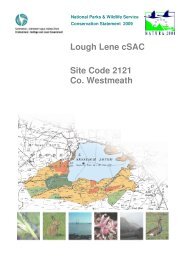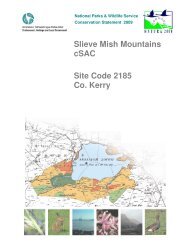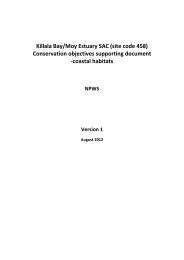The beetles of decaying wood in Ireland - National Parks & Wildlife ...
The beetles of decaying wood in Ireland - National Parks & Wildlife ...
The beetles of decaying wood in Ireland - National Parks & Wildlife ...
Create successful ePaper yourself
Turn your PDF publications into a flip-book with our unique Google optimized e-Paper software.
Saproxylic <strong>beetles</strong> <strong>of</strong> <strong>Ireland</strong><br />
____________________________<br />
<strong>The</strong> data is primarily derived by extraction from published literature and contact with the active<br />
recorders that are known to the authors. <strong>The</strong> record is almost certa<strong>in</strong>ly not complete however, as<br />
unpublished <strong>in</strong>formation will largely rema<strong>in</strong> uncollated for the time be<strong>in</strong>g.<br />
Analysis <strong>of</strong> status<br />
274 species are listed <strong>of</strong> which at least 208 are native – see Table 1. N<strong>in</strong>e <strong>of</strong> these species may now be<br />
ext<strong>in</strong>ct, hav<strong>in</strong>g not been reported s<strong>in</strong>ce Johnson & Halbert (1902) – see below. This is clearly a rich<br />
fauna, despite the various op<strong>in</strong>ions which have been expressed over the years – see Introduction.<br />
However, only 25 species can be considered common and widespread, <strong>in</strong> contrast to the 104 (50%)<br />
species which have been assessed as rare <strong>in</strong> <strong>Ireland</strong>. This suggests a serious imbalance <strong>in</strong> species<br />
status, reflect<strong>in</strong>g the overall rarity and fragility <strong>of</strong> saproxylic habitats across <strong>Ireland</strong>.<br />
Eight additional species are thought to be doubtfully Irish as only old records have been reported and<br />
no support<strong>in</strong>g voucher specimens are available, while the status <strong>of</strong> a further 8 have proved impossible<br />
to assess on the scant <strong>in</strong>formation available. 35 species are established non-natives, largely<br />
accidentally brought <strong>in</strong> by commercial forestry activities. <strong>The</strong>re is also a clear trend <strong>of</strong> recent arrivals<br />
mak<strong>in</strong>g first landfall <strong>in</strong> Northern <strong>Ireland</strong>, presumably carried from Scotland on air currents – 8 species<br />
have first appeared <strong>in</strong> the north-eastern counties and have proceeded to spread.<br />
<strong>The</strong> species presumed to be ext<strong>in</strong>ct <strong>in</strong> <strong>Ireland</strong> are: Nossidium pilosellum (Marsham), Amphicyllis globus<br />
(F.), Agathidium rotundatum Gyllenhal, Euplectus punctatus Mulsant, Cypha sem<strong>in</strong>ulum (Erichson),<br />
Calambus bipustulatus (L.), Malthodes dispar (Germar), Anthocomus fasciatus (L.) and Conopalpus testaceus<br />
(Olivier). <strong>The</strong>se represent a wide variety <strong>of</strong> saproxylic habitat types.<br />
4<br />
Figure 1: <strong>The</strong> dist<strong>in</strong>ctive larva <strong>of</strong> the Red-headed Card<strong>in</strong>al Beetle Pyrochroa serraticornis © Keith Alexander



